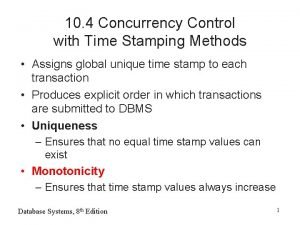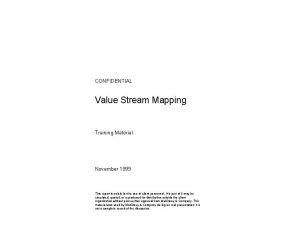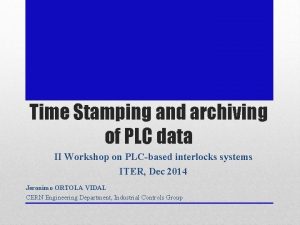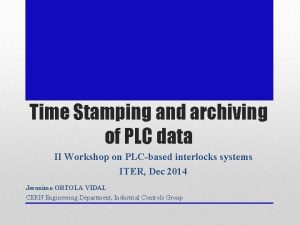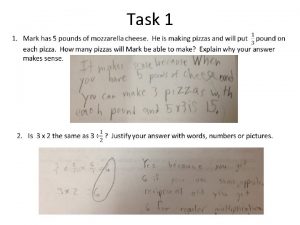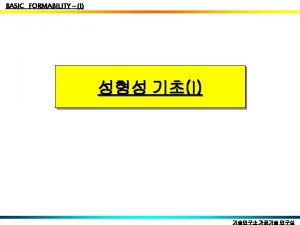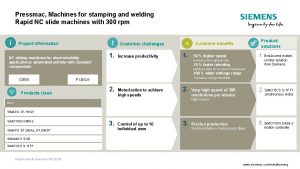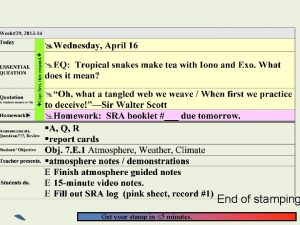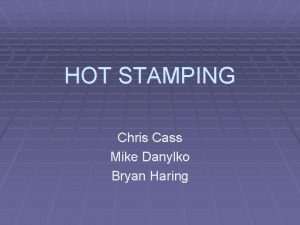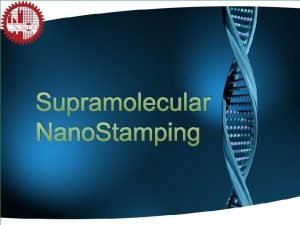Time Stamping Task Introduction and Work Group Overview













- Slides: 13

Time Stamping Task. Introduction and Work Group Overview Ian Lazarus (STFC Daresbury)

Overview of talk: • Introduction: – – – What is Time Stamping? Why do we do it? How do we do it? Problems to consider. Examples of Time Stamping • Working Group – What should we do? – Who will participate?

What is Time Stamping? • Associate time label with data from a channel, a subsystem or a system. • Fixed time relationship to moment when channel fired or event generated • Permits the use of these time stamps to correlate data within detectors, between systems. • Simplest form is to correlate multiple free running systems (c. f. 1991 RDT experiments at Daresbury NSF) • Note: Hardware triggers can be used too if necessary but many benefits of TS are lost if data is thrown away in this way.

Why do we do Time Stamping? • Eliminates dead time (but not pileup) • Allows software triggering which hugely increases flexibility: – Software can look back/forward in time (time=buffer size) – Can take 100% of low rate in delayed coincidence with high rate (minimal dead time losses) – Can correlate multiple systems without cross-triggering cables. – Can easily do multiplicity triggers in systems with huge channel counts – Eliminate huge number of trigger connections (no problems from cables, ground/isolation) – Overcome latency in pipelined processing (digital or analogue) • Summary: Better data selection

How do we do Time Stamping? • Need stable clock, lined up everywhere (adjust delay/phase) • Need local TS logic in channel/sub-system/system • Need a regular pulse to “timeframe” data (and lack of data) • Need a powerful processing system and lots of memory • Can be used with analogue or digital signal processing. • Can be used alongside conventional hardware triggered readout, but with limited results.

Problems to consider when Time Stamping? • • • Need timestamps in ASICs (c. f. XYTER talk, also STFC CZT ASIC, CALICE MAPS, planned R 3 B Si ASIC. Others? ) Latency- doesn’t matter until we make connections to ancillary detectors- crosssystem triggers with analogue triggers Buffer edge effects (time/channels) Time alignment (setup) is critical – – – sub ns for AGATA PSA for simple coincidence must be better than half a clock across all systems for To. F must be few tens of ps (or calibrated) – – For ps To. F timing we still need to use TACs Should also calibrate the To. F channels for clock alignment errors To. F not easy- TS is only as accurate as the clock (or clock divided by 2 or 4) after alignment and jitter errors. Bandwidth for readout of high rate beam tracking (or links to feed in lists of interesting timestamp ranges to local readout)

Examples of NP Time Stamping Systems • • • GREAT TDR (UK/Finland, Jyvaskala)- working CENTRUM (GANIL)- working CENTRUM plus ATOM (GANIL) under design? AGATA GTS system (Europe) designed; being built BUTIS (GSI/FAIR) Built (local distribution being specified)

Time Stamping example 1 GREAT TDR

Time Stamping example 2 CENTRUM • Time Stamps Events (not channels) • Correlates EXOGAM with VAMOS and TIARA • ATOM upgrade adds channel timestamps

Time Stamping example 3 AGATA

Time Stamping example 4 – NUSTAR (BUTIS) More later from Haik…

Time Stamping example 5 – AIDA (De. Spec) 16 ch ASIC ASIC ASIC 16 FADCs (12/14 bit) 1 Sliding Scale ADC (14 bit) per ASIC 16 FADCs 1 SS ADC 16 FADCs 1 SS ADC Virtex 4 LX FPGA ADC Readout FADC PSA Timestamp control ASIC Control Slow Control TDR or BUTIS or. . . TS Port Virtex 4 FX FPGA (or V 5) PPC (Unix) MGT (raw/PCIe) More processing? Data Output Fibre Driver (Laser) Ethernet physical interface

Time Stamping Working Group • What shall we do? – – – Review existing systems Review planned systems Exchange information Consider strengths and weaknesses of known systems Should we standardise on one system? Can we make a common TS port (c. f. AIDA for De. Spec) • Who will participate? – All are welcome…
 Time stamping in dbms
Time stamping in dbms Time stamping
Time stamping Acme stamping value stream mapping
Acme stamping value stream mapping Before you were mine
Before you were mine Sintered gear manufacturing process
Sintered gear manufacturing process An example of a mutual aid or reciprocal group is:
An example of a mutual aid or reciprocal group is: Objectives of group work in social work
Objectives of group work in social work Work group vs work team
Work group vs work team Smart work vs hard work group discussion
Smart work vs hard work group discussion Tiered task bias task
Tiered task bias task What is bioinformatics an introduction and overview
What is bioinformatics an introduction and overview Start time end time and elapsed time
Start time end time and elapsed time Ward accreditation programme
Ward accreditation programme Papercut job ticketing
Papercut job ticketing
